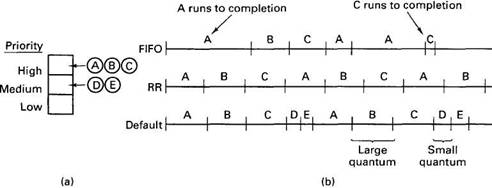Книга: Distributed operating systems
10.2.2. Scheduling
10.2.2. Scheduling
Thread scheduling is similar to process scheduling, except that it is visible to the application. The scheduling algorithm determines how long a thread may run, and which thread runs next. Just as with process scheduling, many thread scheduling algorithms are possible.
Threads in DCE have priorities and these are respected by the scheduling algorithm. High-priority threads are assumed to be more important than low-priority threads, and therefore should get better treatment, meaning they run first and get a larger portion of the CPU.
DCE supports the three thread scheduling algorithms illustrated in Fig. 10-4. The first, FIFO, searches the priority queues from highest to lowest, to locate the highest priority queue with one or more threads on it. The first thread on this queue is then run until it finishes, either by blocking or exiting. In principle, the selected thread can run as long as it needs to. When it has finished, it is removed from the queue of runnable threads. Then the scheduler once again searches the queues from high to low and takes the first thread it finds.

Fig. 10-4. (a) A system with five threads and three priority levels. (b) Three thread scheduling algorithms.
The second algorithm is round robin. Here the scheduler locates the highest populated queue and runs each thread for a fixed quantum. If a thread blocks or exits before its quantum is up, it is (temporarily) removed from the queue system. If it uses up its entire quantum, it is suspended and placed at the end of its queue. In the middle example of Fig. 10-4(b), the threads A, B, and C will run alternately forever if they want to. The medium-priority threads D and E will never get a chance as long as one of the high-priority threads wants to run.
The third algorithm is the default algorithm. It runs the threads on all the queues using a time-sliced round-robin algorithm, but the higher the priority, the larger the quantum a thread gets. In this manner, all threads get to run and there is no starvation as in the second algorithm.
There is also a fourth algorithm that has variable-sized quanta, but with starvation. However, this one is not defined by POSIX, so it is not portable and should be avoided.
- Scheduling Tasks
- Using Priority Scheduling and Control
- Creating and scheduling backups with Wbadmin
- 17.1.3. Linux Scheduling
- 4.4. SCHEDULING IN DISTRIBUTED SYSTEMS
- 4.6.4. Real-Time Scheduling
- 8.2.3. Scheduling
- 9.2.3. Scheduling
- Scheduling and prioritizing print jobs
- Scheduling the printing of individual documents
- 4.4.5 Scheduling Algorithms
- 5.3 Task States and Scheduling




